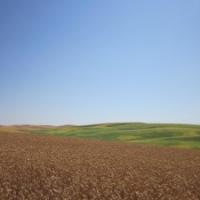Obstacles in the Oilseed Biofuel Market
In a previous post, I explained that available evidence currently indicates nitrous oxide emissions may be fairly low in the inland Pacific Northwest, compared to other cropland agricultural systems in the U.S. and world. If ongoing research confirms these early results, then I suggested that efforts to reduce nitrous oxide emissions need to focus on strategies that offered strong co-benefits.
One such strategy is the use of precision nitrogen application tools to closely match plant nitrogen needs as they vary within fields.Precision nitrogen technologies are particularly appropriate in the Palouse region of Washington and Idaho, where soils, water dynamics, and thus yields can vary quite significantly across the rolling landscape. In the photo at left, you can see different rates of crop drying, related to variation in soil factors that influence how much water the soils hold.
A recent video featuring Eric Odberg (produced by WSU’s Sylvia Kantor) does a nice job of profiling Eric’s use of this technology. Eric isn’t adopting this practice specifically because it reduces nitrous oxide emissions, though available research1 suggests that nitrous oxide emissions will likely be reduced in low-yielding areas of the field that had previously been receiving excess nitrogen. Rather, Eric wants to have a farming operation that is environmentally and economically sustainable. As he says, “I’m fourth generation, and hope to be able to hand it to the fifth generation. Having a sustainable farm is an important part of that….but [I] also want it to be profitable.” Using precision N technologies, Eric has been able to reduce his nitrogen use by about 15%, benefitting both his bottom line and the environment.
Oregon, consistently striving for sustainability, has established their own form of tax credits, and biofuels are continuing to expand throughout the country. Like many of the federal incentives Oregon has plenty of energy credits to help offset the initial cost of starting a processing plant but, the most predominate law is the producer tax credit (OR HB-2210). This is a credit that goes to the farmer giving money back for growing certain crops for biofuels. Farmers can receive up to $0.05 a pound for oil-seeds and an additional $0.10 if they process the oil-seed on site and send the oil to a refinery--which some REACCH region producers are doing with great success. Unfortunately with current prices the demand isn’t there for farmers, producers, or consumer to have more bio-fuels when the cost of regular gasoline is cheaper.
The video is accompanied by a written case study that provides additional detail about Eric’s thinking. We hope that this case study can be a resource for other dryland growers interested in adopting precision N technologies. Additional case studies in the series will examine other strategies that innovative farmers in the PNW are using to enhance their resilience in the face of climate change.
1Sehy, U., R. Ruser and J.C. Munch. 2003. Nitrous oxide fluxes from maize fields: Relationship to yield, site-specific fertilization, and soil conditions. Agriculture, Ecosystems and the Environment. 99:97-111.
Editor: Nerissa Schmechel


If you’re interested in climate and agriculture, continue reading articles at the blog aggregator, AgClimate.net

